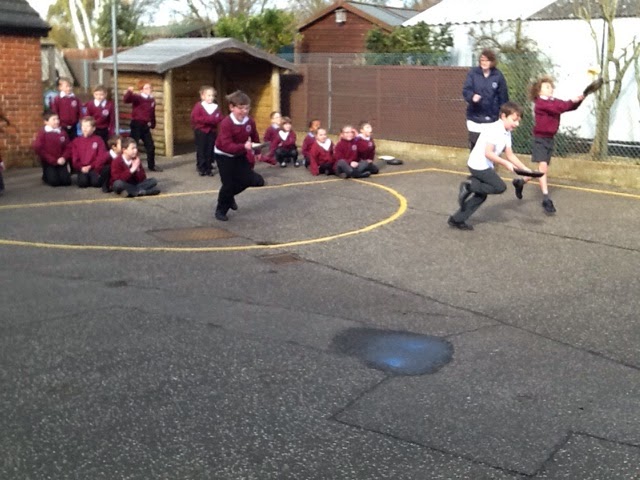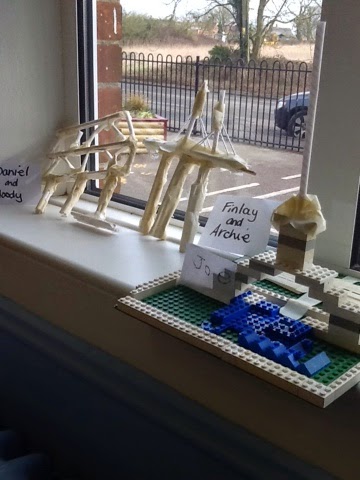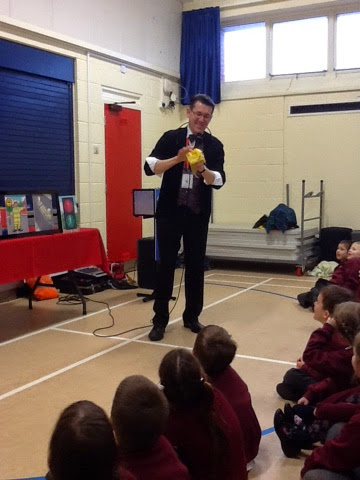Monday, 23 February 2015
Friday, 13 February 2015
French Bridges
What do you think about our models and drawings of bridges? Class 3 have done some fantastic work this week.
Thursday, 12 February 2015
Road Safety Magic!
Today we had a bit of a treat!
A magician called Olly Day came and talked to Classes 2 and 3 about road safety and how to cross the road with care. He showed us the dangers of crossing from between parked cars and about being careful in car parks where cars reverse.
We did a magic trick to help us remember to stop, look and listen.
Olly explained how fluorescent strips can help us to be safe in the dark.
He told us never to play on the road and to wear colours like yellow which help you to be seen in the dark. Reflectors also work really well.
You must be safe when you cycle and wear your cycle helmet, which protects you if you fall off your bike. Olly showed us a photo of an 11 year old boy who hit his head on the road. His Dad took the photo and asked Olly to show as many children as possible to help them remember to wear a helmet.
It's also really important to wear seat belts - and it's the law!
10 children a week are hurt on the roads in Norfolk, so be careful and look after yourself!
Wednesday, 4 February 2015
French Landscapes and Painters
This afternoon we looked at some photographs of French towns and talked about them. We discussed the architecture and how old it was, the location of the towns and also what they were famous for. Examples included La Rochelle,
Chartres,
Lourdes,
Versailles
and Carcassonne.
Then we looked at some French landscape paintings...
Everyone chose their favourite and then explained why they liked it in their topic books. This continues our investigation into famous French painters.
Tuesday, 3 February 2015
Road Safety
Mike came to talk to us today about road safety.
We all know that we must stop, listen and look when crossing the road.
Today we thought about catapults, which are not just used for games. They are also used in fishing and in warfare. Why would Mike tell us about catapults when he came to discuss road safety?
Mike showed us a model of a medieval catapult which would have been about twice as big as the school and we had a demonstration and an explanation of how it worked. A winch allows a person to put a great deal of energy into the
catapult. Then all of the energy releases at once,
throwing the projectile through the air.
Mike explained how you would get catapulted inside a car if it stopped suddenly and you weren't wearing your seat belt.
He had a model to demonstrate.
The child in the model was catapulted from the back seat through the windscreen. Its head came first. The parents sitting in the front also went through the windscreen.
Mike also talked about loose items in the car and what would happen to them in an accident. A box of tissues flying through the air in an accident would have the force of a brick. Items become 4 times heavier if the car stops at 30 miles per hour. A child weighing would hit the windscreen with the force of a baby elephant. If the car is travelling faster the force is greater. If you hit another car travelling at speed the force is greater again.
A child in the back seat could hit an adult sitting in the front with a lot of force if they're not wearing their seat belt.
Make sure your seatbelt isn't underneath your chin. It should be across your chest. An adult seatbelt is for someone who is at least 1.35 m tall (around the height of a light switch on the wall). If you aren't that tall you should have a booster seat (or a special seat for babies and very young children).
Mike told us how important it is to drive at the correct speed, according to road signs and the law, and also to leave a good stopping gap between cars. It is really important to concentrate when driving.
It is really important to wear your seatbelt. Wear them all the time, even on short journeys.
Jelly Worms!
Mrs Andrew made some jelly worms using jelly and straws and brought them in to share.
1 packet orange jelly
1 packet raspberry jelly
3 leaves of gelatine
250 mls boiling water
200 mls cold water
1. Put straws in a tall glass.
2. Dissolve jelly in the boiling water - ASK AN ADULT TO HELP YOU!
3. Dissolve gelatine in jelly mixture.
4. Add cold water.
5. Put jelly in the glass so that it fills the straws.
6. Leave to set in the fridge for 6 hours.
Enjoy!
Monday, 2 February 2015
Poetry: Peer Assessment
This morning we looked at the circular poems we completed last week and peer assessed them. We used three important skills that are required in Class 3: listening, independent learning and working well with others. A display of the poetry we have been working on this term will be put up in the library sometime soon.

Subscribe to:
Posts (Atom)















































